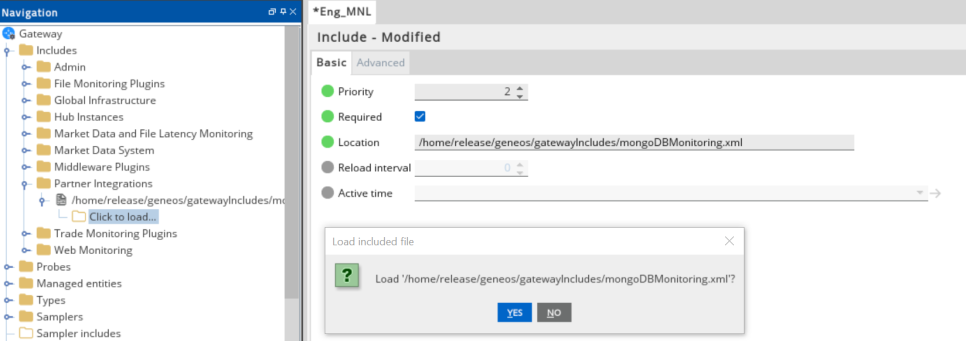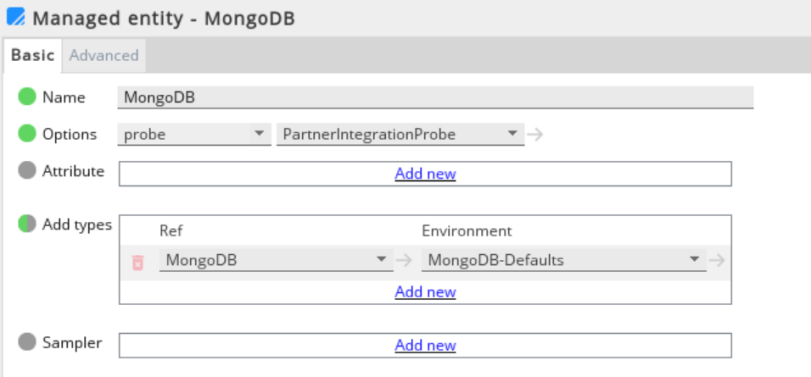If you are currently using version 5.x.x, we advise you to upgrade to the latest version before the EOL date. You can find the latest documentation here.
MongoDB Monitoring User Guide
Overview
MongoDB monitoring is a Gateway configuration file that enables monitoring of MongoDB through the Toolkit plug-in.
MongoDB can monitor the database environment in a measurable way to spot any potential discrepancies and issues.
Some key areas to track when using MongoDB monitoring:
| Key Area | Description |
|---|---|
| Metrics | Determine the crucial alerts to be set in the metrics to avoid any performance issues or errors. |
| Database performance | Monitor the database's current state. |
| Resource utilisation | Monitor the number of client connections to avoid abnormal traffic loads that can lead to performance issues. |
| Asserts | Show errors raised during the selected time period. |
MongoDB helps you to get an overview of database operations, such as:
- Track the current state of database.
- View reports of asserts on the database.
- Monitor the metrics for write performance.
- View contains storage statistics for a given database.
- Check reports information regarding the state and use of indexes in MongoDB.
To view the sample metrics and dataviews, see MongoDB Monitoring Technical Reference.
Intended audience
This guide is intended for users who are setting up, configuring, troubleshooting and maintaining this integration. Once the integration is set up, the samplers providing the dataviews become available to that Gateway.
As a user, you should be familiar with MySQL or any other database, and with the administration of the MongoDB servers.
Prerequisites
The following requirements must be met prior to the installation and setup of the template:
- A machine running the Netprobe must have access to the host where the MongoDB instance is installed and the port MongoDB is listening to.
- Netprobe version 4.6 or higher.
- Gateway version 4.8 or higher.
- MongoDB version 3.6.
Installation procedure
Ensure that you have read and can follow the system requirements prior to installation and setup of this integration template.
- Download the integration package
geneos-integration-mongoDB-<version>.zipfrom the ITRS Downloads site. - Open Gateway Setup Editor.
- In the Navigation panel, click Includes to create a new file.
- Enter the location of the file to include in the Location field. In this example, it is the
include/MongoDBMonitoring.xml. - Update the Priority field. This can be any value except
1. If you input a priority of1, the Gateway Setup Editor returns an error. - Expand the file location in the Include section.
- Select Click to load.
- Click Yes to load the new MongoDB include file.
- Click Managed entities in the Navigation panel.
- Add the MongoDB type to the Managed Entity section that you will use to monitor MongoDB.
- Click Validate current document
 to check your configuration.
to check your configuration. - Click Save current document
 to apply the changes.
to apply the changes.


Set up the samplers
These are the pre-configured samplers available to use in MongoDBMonitoring.xml.
Configure the required fields by referring to the table below:
| Samplers |
|---|
| MongoDB-dbStats |
| MongoDB-Locks |
| MongoDB-Memory |
| MongoDB-BackgroundFlushing |
| MongoDB-Opcounters |
| MongoDB-Asserts |
| MongoDB-Instance |
| MongoDB-Cursors |
| MongoDB-ConcurrentTransactions |
| MongoDB-Replication |
Set up the variables
The MongoDBMonitoring.xml template provides the following variables that are set in the Environments section:
| Variables | Description |
|---|---|
| MONGODB_SAMPLE_INTERVAL | Sample interval used by all the Mongo samplers. |
| MONGODB_CLIENT | Full path of the Mongo client. The toolkit script uses this to communicate with the MongoDB instance. |
| MONGODB_GROUP | Group name used by all the Mongo Samplers. |
| MONGODB_CONNECTION |
Follow the format <host>:<port>
|
| MONGODB_SCRIPT_DIR | Directory where the sampler scripts will be generated. |
| MONGODB_DB | Specifies the name of the database to connect to. |
Note: The default values can be changed by providing an environment named Mongo with a higher priority in the set-up file, or by using an environment in the Managed entity where the type is defined.
Set up the rules
The MongoDBMonitoring-SampleRules.xml template also provides a separate sample rules that can be used to configure the Gateway Setup Editor.
Your configuration rules must be set in the Includes section. In the Navigation panel, click Rules
The table below shows the included rules in the integration file.
| Sample Rules |
|---|
| MongoDB-Asserts |
| MongoDB-CursorsWithTimeout |
| MongoDB-TicketAvailability |
| MongoDB-ReplicaState |
| MongoDB-ReplicationLag |